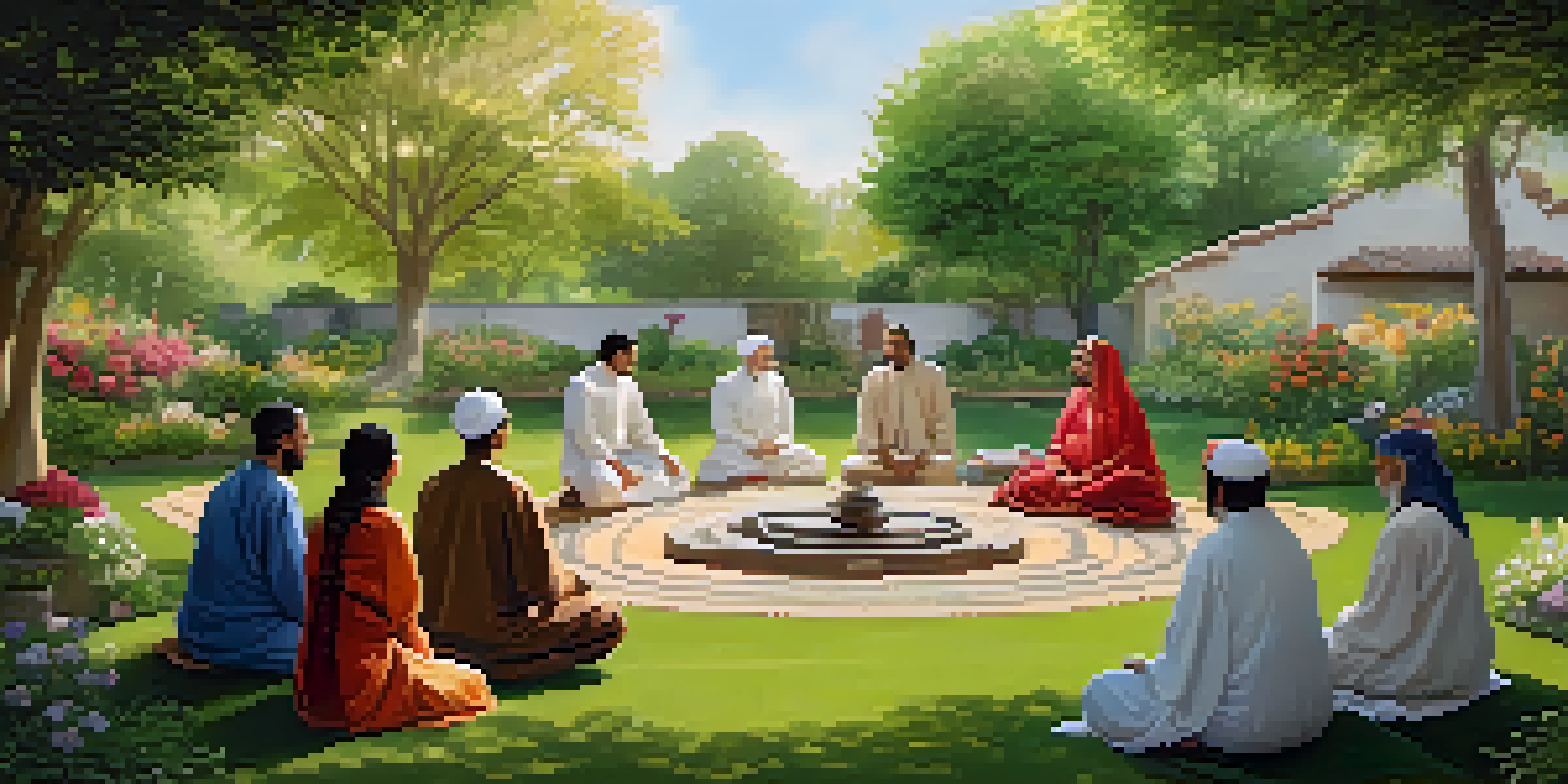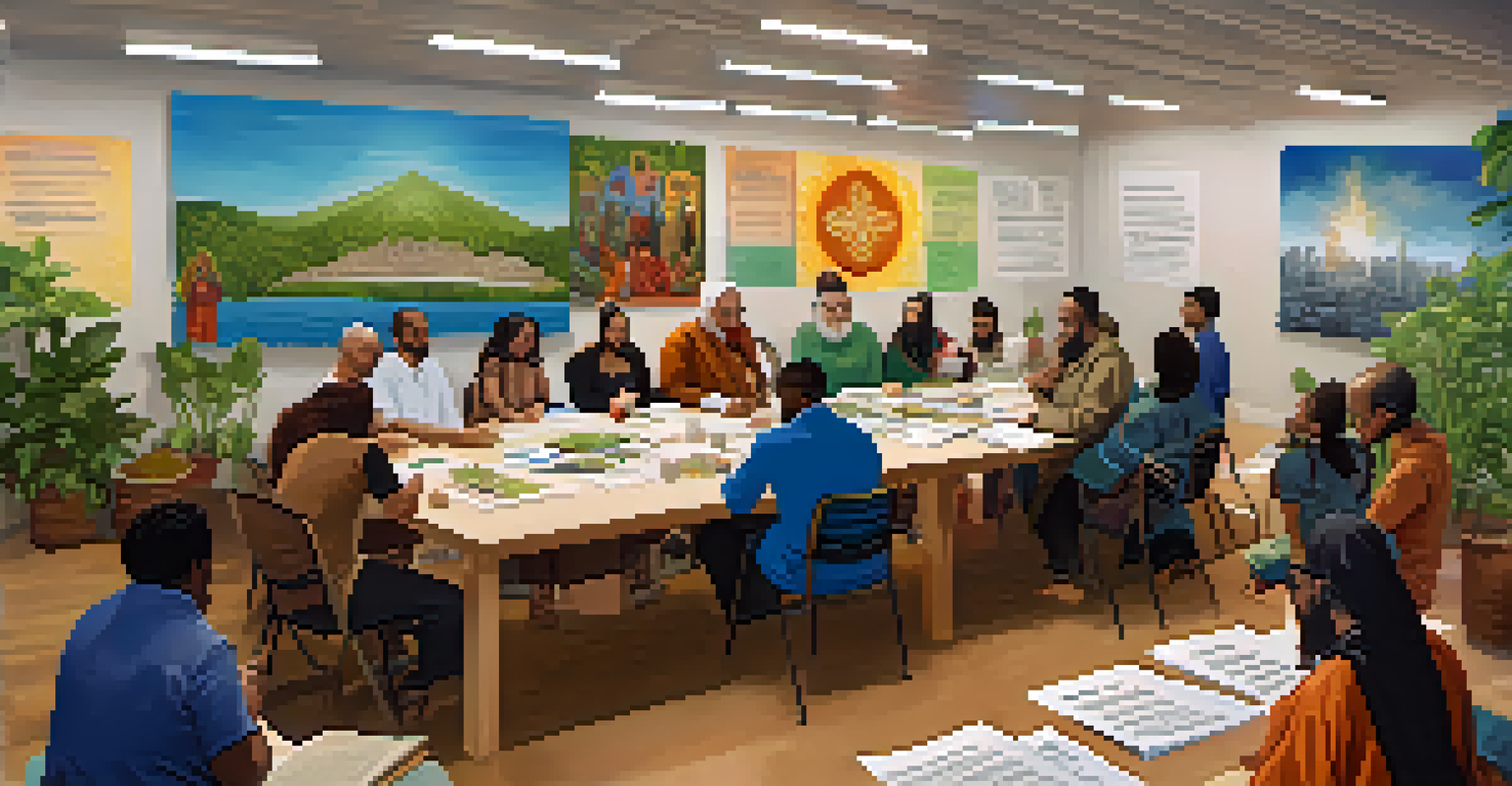Interfaith Dialogue: Lessons Learned from Historical Contexts

The Roots of Interfaith Dialogue in Ancient Civilizations
Interfaith dialogue has deep roots that can be traced back to ancient civilizations. Cultures like those in Mesopotamia and Egypt engaged in exchanges that reflected their diverse religious beliefs. These early interactions often laid the groundwork for mutual respect and understanding among different faiths.
Dialogue is the most effective way to resolve conflict and to build understanding across differences.
For instance, the ancient Greeks invited philosophers from various backgrounds to discuss moral and ethical questions, promoting a culture of dialogue. This practice demonstrated how conversations across faiths can foster cooperation and shared values. These early examples remind us that interfaith dialogue is not a modern concept but a long-standing practice.
Recognizing these historical contexts allows us to appreciate the importance of dialogue in promoting peace and unity. Just as ancient societies engaged in respectful discussions, we can draw inspiration from their examples to address contemporary challenges in a diverse world.
Medieval Interactions: A Tapestry of Faiths
The medieval period was marked by significant interactions between different faiths, particularly during the Crusades. Although these events are often viewed through a lens of conflict, they also facilitated exchanges of ideas and cultures. Scholars from Christian, Jewish, and Islamic traditions engaged in dialogue that enriched their respective faiths.

Take, for example, the work of medieval Muslim scholars who preserved and expanded upon Greek philosophical texts. Their contributions influenced European thinkers, showcasing how interfaith dialogue can lead to intellectual growth. This era serves as a reminder that even amidst conflict, opportunities for understanding can arise.
Interfaith Dialogue's Ancient Roots
Interfaith dialogue has a rich history, beginning in ancient civilizations where diverse beliefs fostered mutual respect and understanding.
By studying these historical moments, we can learn the importance of dialogue in bridging divides. Emphasizing shared knowledge and collaboration, we can create a foundation for modern interfaith efforts that prioritize understanding over division.
The Enlightenment: Dialogue as a Tool for Progress
The Enlightenment era brought about a shift in how faith and reason were perceived, leading to increased dialogue between different religious traditions. Thinkers like Voltaire and John Locke advocated for tolerance and the examination of beliefs, paving the way for more open discussions. This period underscored the significance of questioning and understanding various perspectives.
The greatest gift of human beings is that we have the power of empathy.
For instance, the discussions surrounding religious freedom became central to Enlightenment thought. By promoting tolerance, these dialogues helped dismantle long-held prejudices and fostered an environment where diverse beliefs could coexist. This historical context emphasizes that interfaith dialogue can drive societal progress.
Understanding the Enlightenment's impact on interfaith dialogue encourages us to embrace open-mindedness today. By valuing reasoned discussion and respecting diverse perspectives, we can continue to advance the principles of tolerance and coexistence.
The Impact of 20th Century Conflicts on Interfaith Dialogue
The tumultuous events of the 20th century, from world wars to the Cold War, highlighted the need for interfaith dialogue. In the aftermath of these conflicts, leaders recognized that fostering understanding among different religious groups was crucial for peace. This realization led to the establishment of various interfaith organizations aimed at promoting dialogue.
For example, the Parliament of the World's Religions, founded in 1893 but revitalized in the 20th century, brought together diverse faiths to discuss pressing global issues. These gatherings emphasized the importance of collaboration in addressing conflicts and building a more peaceful world. This historical moment shows us how crises can catalyze meaningful dialogue.
Modern Initiatives for Global Issues
Today, interfaith initiatives effectively address global challenges like climate change, demonstrating the power of collaboration among diverse faiths.
By reflecting on the lessons learned from the 20th century, we are reminded of the power of interfaith dialogue in healing and reconciliation. Embracing dialogue as a tool for peace allows us to address contemporary challenges with a shared commitment to understanding.
Modern Interfaith Initiatives and Their Successes
Today, interfaith initiatives continue to thrive, showcasing the power of dialogue in addressing global issues. Organizations like the United Nations Interfaith Harmony Week promote collaboration among different faiths to tackle challenges such as poverty and climate change. These initiatives demonstrate how interfaith dialogue can lead to tangible, positive outcomes.
One successful example is the 'Faith and Climate Change' initiative, which brings together religious leaders to advocate for environmental action. By uniting diverse faith traditions around a common cause, these dialogues foster a sense of shared responsibility. This contemporary approach highlights the relevance of interfaith dialogue in addressing urgent global concerns.
As we look at modern interfaith initiatives, it becomes clear that dialogue can serve as a catalyst for social change. By working together across faiths, we can create solutions that benefit everyone, reinforcing the importance of collaboration in our interconnected world.
Challenges in Interfaith Dialogue: Overcoming Misunderstandings
Despite its benefits, interfaith dialogue often faces challenges, particularly when misunderstandings arise. Different cultural contexts and interpretations of beliefs can lead to friction, making it difficult to engage in constructive conversations. Recognizing these challenges is the first step toward fostering effective dialogue.
For instance, misconceptions about a particular faith can hinder open discussions. By addressing these stereotypes and promoting accurate representations, we can create a more welcoming environment for dialogue. This effort requires active listening and a willingness to learn from one another.
Overcoming Misunderstandings
Addressing misconceptions and promoting empathy are crucial for successful interfaith dialogue and fostering meaningful connections.
Overcoming misunderstandings is crucial for the success of interfaith dialogue. By approaching conversations with empathy and a genuine desire to understand, we can bridge gaps and foster a spirit of collaboration, essential for any meaningful dialogue.
The Future of Interfaith Dialogue: Building on Historical Lessons
As we look to the future, the lessons learned from historical interfaith dialogues can guide our efforts in promoting understanding. Emphasizing the importance of respect and open-mindedness, we can create spaces for meaningful conversations. These principles, rooted in history, are essential for fostering a harmonious coexistence.
Moreover, incorporating technology into interfaith dialogue can enhance communication and reach broader audiences. Online platforms allow individuals from diverse backgrounds to share their experiences and insights, fostering a global dialogue. This modern approach can complement traditional methods and make interfaith conversations more accessible.

By harnessing the lessons of history and embracing new technologies, we can cultivate a culture of dialogue that transcends boundaries. The future of interfaith dialogue holds great potential for creating a more inclusive and understanding world, where diverse beliefs can thrive together.